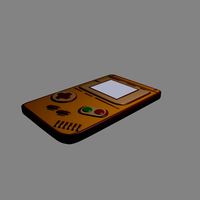CG Trader

Scimitar Sword Game Ready
by CG Trader
Last crawled date: 1 year, 10 months ago
Low Poly game-ready 3D Scimitar sword made in Blender. Texture packed into blend file. To preview and inspect the 3D model please use the link below:
https://bit.ly/3qdaLPG Thank you! The following are regional variations, that are within the scimitar family of swords. Note that while these loan-words are used in English to refer to specific sword designs, in many cases (at various stages in history) in their native languages they often will translate to the word sword, of any design. Shamshir (Iran and Pakistan)
Kilij (Turkey and Egypt), one of the oldest known examples from the early 14th century
Nimcha
Pulwar
Talwar
Kirpaan
Shotel The English term scimitar is attested from the mid-16th century, derives from either the Middle French cimeterre (15th century) or from the Italian scimitarra. The ultimate source of these terms is unknown. Perhaps they are corruptions of the Persian shamshir, but the OED finds this explanation unsatisfactory. The Persian word shamshēr which literally means “paw claw,” due to its long, curved design. The word has been translated through many languages to end at scimitar. In the Early Middle Ages, the Turkic people of Central Asia came into contact with Middle Eastern civilizations through their shared Islamic faith. Turkic Ghilman mamelukes serving under the Umayyad and Abbasid Caliphates introduced kilij type sabers to all of the other Middle Eastern cultures. Previously, Arabs and Persians used straight-bladed swords such as the earlier types of the Arab saif, takoba and kaskara. During Islamization of the Turks, the kilij became more and more popular in the Islamic armies. When the Seljuk Empire invaded Persia and became the first Turkic Muslim political power in Western Asia, kilij became the dominant sword form. The Iranian shamshir was created during the Turkic Seljuk Empire period of Iran. The term سَيْف saif in Arabic can refer to any Middle Eastern (or North African, South Asian) sword, straight or curved. The Arabic word cognates with the ancient Greek xiphos. The Greek word may have been borrowed from a Semitic language, as both saif and xiphos go back to an old (Bronze Age) wanderwort of the eastern Mediterranean, of unknown ultimate origin. Richard F. Burton derives both words from the Egyptian sfet. sword scimitar melee military metal teture gameready nature sharp knight bladed weapon kilic army medieval smooth war sabre backsword weapon game medieval knight
https://bit.ly/3qdaLPG Thank you! The following are regional variations, that are within the scimitar family of swords. Note that while these loan-words are used in English to refer to specific sword designs, in many cases (at various stages in history) in their native languages they often will translate to the word sword, of any design. Shamshir (Iran and Pakistan)
Kilij (Turkey and Egypt), one of the oldest known examples from the early 14th century
Nimcha
Pulwar
Talwar
Kirpaan
Shotel The English term scimitar is attested from the mid-16th century, derives from either the Middle French cimeterre (15th century) or from the Italian scimitarra. The ultimate source of these terms is unknown. Perhaps they are corruptions of the Persian shamshir, but the OED finds this explanation unsatisfactory. The Persian word shamshēr which literally means “paw claw,” due to its long, curved design. The word has been translated through many languages to end at scimitar. In the Early Middle Ages, the Turkic people of Central Asia came into contact with Middle Eastern civilizations through their shared Islamic faith. Turkic Ghilman mamelukes serving under the Umayyad and Abbasid Caliphates introduced kilij type sabers to all of the other Middle Eastern cultures. Previously, Arabs and Persians used straight-bladed swords such as the earlier types of the Arab saif, takoba and kaskara. During Islamization of the Turks, the kilij became more and more popular in the Islamic armies. When the Seljuk Empire invaded Persia and became the first Turkic Muslim political power in Western Asia, kilij became the dominant sword form. The Iranian shamshir was created during the Turkic Seljuk Empire period of Iran. The term سَيْف saif in Arabic can refer to any Middle Eastern (or North African, South Asian) sword, straight or curved. The Arabic word cognates with the ancient Greek xiphos. The Greek word may have been borrowed from a Semitic language, as both saif and xiphos go back to an old (Bronze Age) wanderwort of the eastern Mediterranean, of unknown ultimate origin. Richard F. Burton derives both words from the Egyptian sfet. sword scimitar melee military metal teture gameready nature sharp knight bladed weapon kilic army medieval smooth war sabre backsword weapon game medieval knight
Similar models
cg_trader
$39

Scimitar
...an shamshir (the origin of the word scimitar), the arab saif, the indian talwar, the north african nimcha, and the turkish kilij.
grabcad
free

sword
...larized in persia by the early 16th century, and had "relatives" in turkey (the kilij), the mughal empire (the talwar).
3d_export
$12

Scimitar 3D Model
...d saif sabre curved bladesouthwest shamshir persian kilij nimcha pulwar talwar knife war
scimitar 3d model firdz3d 74238 3dexport
cg_trader
$10

Middle eastern curved sword
.... sword persian persiansword curvedsword middleeastern arabian arabiansword turkishsword kilij shamshir historical military melee
3dwarehouse
free

Shamshir
... sword with a radical curve. -using sketchuppro 2016 -in measurements -feel free to comment #shamshir #sword #blade #persia #iran
cg_trader
$2

Persian Scimitar
...odel with game-ready polycount and pbr textures. scimitar sword arabian middle eastern medieval dagger blade knife military melee
3dwarehouse
free

Minaret Palace2
...just call it middle-eastern. #arab #iran #iranian #middle_east #middle_eastern #minaret #palace #persia #persian #turkey #turkish
cg_trader
$6

10 Models of Arabic houses and36 models of middle Eastern object
...n islamic islam asia africa home house basemash kitbash middle eastern middleeast middle east exterior city urban old environment
3dwarehouse
free

Shamshir sword
...shamshir sword
3dwarehouse
basic construction of a shamshir, traditional persian/ turkish sword.
turbosquid
$5

Scimitar - Middle Eastern Sword
...itar - middle eastern sword for download as max, obj, and fbx on turbosquid: 3d models for games, architecture, videos. (1471344)
Scimitar
turbosquid
$50

Scimitar
... available on turbo squid, the world's leading provider of digital 3d models for visualization, films, television, and games.
turbosquid
$25

Scimitar
... available on turbo squid, the world's leading provider of digital 3d models for visualization, films, television, and games.
turbosquid
$5

Scimitar
... available on turbo squid, the world's leading provider of digital 3d models for visualization, films, television, and games.
turbosquid
$3

Scimitar
... available on turbo squid, the world's leading provider of digital 3d models for visualization, films, television, and games.
turbosquid
$2

Scimitar
... available on turbo squid, the world's leading provider of digital 3d models for visualization, films, television, and games.
turbosquid
$2

Scimitar
... available on turbo squid, the world's leading provider of digital 3d models for visualization, films, television, and games.
turbosquid
$1

Scimitar
... available on turbo squid, the world's leading provider of digital 3d models for visualization, films, television, and games.
turbosquid
free

Scimitar
... available on turbo squid, the world's leading provider of digital 3d models for visualization, films, television, and games.
turbosquid
free

scimitar
... available on turbo squid, the world's leading provider of digital 3d models for visualization, films, television, and games.
3d_export
$10

Scimitar 3D Model
...scimitar 3d model
3dexport
sword scimitar
scimitar 3d model iisam 44184 3dexport
Sword
3d_ocean
$3

sword
...sword
3docean
sword
a high quality sword .
3d_export
$5

sword
...sword
3dexport
a sword made in a blender, a quality sword
3d_export
$35

Sword
...sword
3dexport
sword
3d_export
$10

sword
...sword
3dexport
sword
3d_export
$6

sword
...sword
3dexport
sword
3d_export
$5

sword
...sword
3dexport
sword
3d_export
$5

sword
...sword
3dexport
sword
3d_export
$5

Sword
...sword
3dexport
sword
3d_export
$5

sword
...sword
3dexport
sword
3d_export
$5

sword
...sword
3dexport
sword
Game
3d_ocean
$4

Games
...games
3docean
3d games models real stick
3d, models, sports, games , trail
turbosquid
$5

Games
...s
turbosquid
royalty free 3d model games for download as skp on turbosquid: 3d models for games, architecture, videos. (1612115)
turbosquid
$65

game
... available on turbo squid, the world's leading provider of digital 3d models for visualization, films, television, and games.
turbosquid
$25

Game
... available on turbo squid, the world's leading provider of digital 3d models for visualization, films, television, and games.
turbosquid
$10

Game
... available on turbo squid, the world's leading provider of digital 3d models for visualization, films, television, and games.
turbosquid
$5

Game
...bosquid
royalty free 3d model gameplay for download as blend on turbosquid: 3d models for games, architecture, videos. (1274934)
3d_ocean
$7

game place
...game place
3docean
children game game park game place kids play luna park play
for kids game place
3d_export
$14

game character
...game character
3dexport
game character use for gaming
turbosquid
$20

Game Ready Car For Video Games
...e 3d model game ready car for video games for download as fbx on turbosquid: 3d models for games, architecture, videos. (1499375)
3d_ocean
$5

Game fence
...game fence
3docean
fence game
a high quality game ready fence.
Ready
turbosquid
$51

ready
... available on turbo squid, the world's leading provider of digital 3d models for visualization, films, television, and games.
turbosquid
$15

Creature_pigman_print-ready
...model creature_pigman_print-ready for download as obj and ztl on turbosquid: 3d models for games, architecture, videos. (1283135)
3d_export
$10

alien ready for animation
...alien ready for animation
3dexport
alien 3d model ready for animation
3d_export
$10

Tractore Game Ready
...tractore game ready
3dexport
high poly game texture (tractor) game ready
3d_export
$5

Pickup TruckGame Ready
...pickup truckgame ready
3dexport
high poly game object (car) game ready
3d_export
free

tavern game-ready
...tavern game-ready
3dexport
game-ready tevern files: .fbx .blender .png
3d_export
$12

Game ready robot
...game ready robot
3dexport
black robot with a sword, game ready,melee,low poly,animetet
3d_ocean
$5

Ready for render scene
... 2013 or higher. need : 3d studio max 2013 or higher, v-ray 2.4 or higher, v-ray physical camera with d.o.f. – ready ! this much
3d_ocean
$20

Game ready Props
...game ready props
3docean
box props
this are 3d game ready props….the archive contains textures and psd files…enjoy
3d_export
$5

Game-ready Cat
...game-ready cat
3dexport
game-ready low-poly animated cat<br>walk, run and hit animations
